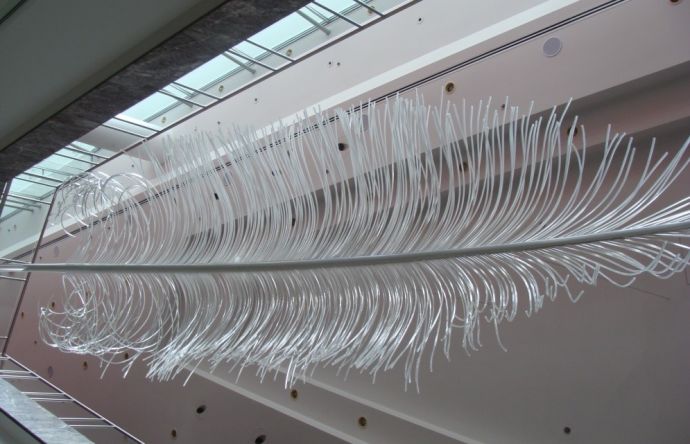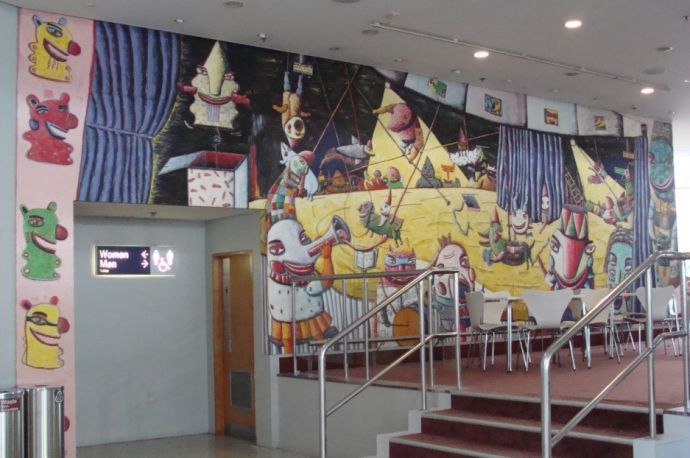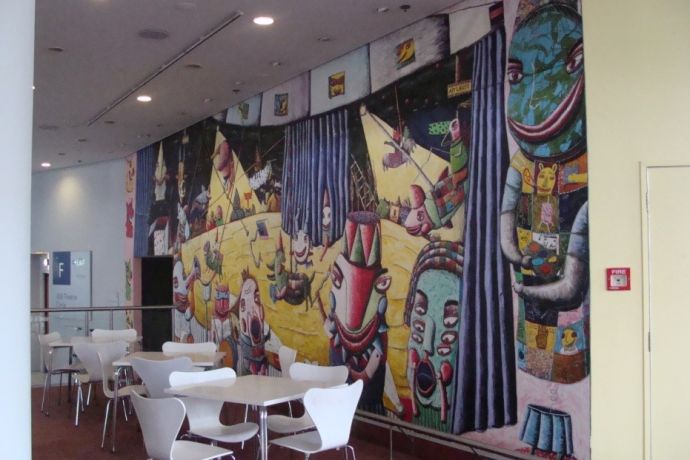AWA: Academic Writing at Auckland
Title: Art in context: The Aotea Centre
|
Copyright: Imogen Allan
|
Description: Evaluation of two art pieces found in Aotea Centre
Warning: This paper cannot be copied and used in your own assignment; this is plagiarism. Copied sections will be identified by Turnitin and penalties will apply. Please refer to the University's Academic Integrity resource and policies on Academic Integrity and Copyright.
Art in context: The Aotea Centre
|
The Aotea Centre:
As a grand civic centre, including conference rooms and theatre, the Aotea Centre has space for many artworks, two of which are Neil Dawson’s Featherlight and Jenny Dolezel’s The Circus of Life. These works are usually viewed in a sociable context by crowds attending performances or receptions held on one of the levels. Featherlight is simple and clever. The concepts of light as in ‘weightlessness’ and in ‘illumination’ are both explored in this sculpture and in its title. Hanging above the main foyer, this huge but realistically styled glass-like feather appears to be floating, the individual filaments curled by the breeze, evoking movement and the physical properties of a feather. Dawson subtlety highlights his skill in giving aluminium, polyester and acrylic such heavy and artificial materials the appearance of being as light and natural as a feather. Meanwhile, light is both captured by and also makes transparent the thin filaments, playing with the physical properties of the materials and providing a dynamic effect, depending on the differing sources of illumination, both natural through the windows and artificial from the electrical lighting. Featherlight is suspended where a chandelier would traditionally hang in a theatre,[1] thereby further integrating the ideas of light into the architectural setting. The subject of a feather reflects the natural world, as does the companion work Spectra, a large paua shell that clings to the ceiling above an adjacent staircase. New Zealand’s unique bird and sea life are often viewed as icons, and by referencing them Dawson ensures Featherlight is easily identifiable to a local audience, as Caughy and Cow say, “an ongoing theme in Dawson’s works is the use of archetypal kiwi images ... these works question the way New Zealand presents itself as a nation.”[2] As a large mural, The Circus of Life occupies a wall in a corner, on the right-hand side of the building. Full of detail, it depicts other-worldly figures undergoing different circus acts on the left, while ‘behind the scenes’ is represented on the right, which conveys internal experiences related to performance: expressing such things as stage-fright, auditioning and memorising roles[3]. While Dawson’s work evokes natural and external spaces, Dolezel focuses on internal spaces, playing with the idea that things are more than they seem.[4] At first her figures appear child-like, suggested by the simplistic, crudely drawn figures and bright, unnatural colours of yellows and pinks, but on second glance these characters appear sinister and “nightmarish”.[5] The more you look, the more the elements of circus take on a metaphorical role, suggesting themes of deception, pretence and pressure of performance.[6] These different levels are reflected in the uneven layering of paint,[7] which the medium of a mural allows for, and links to the way Dolezel “sees people – their inner secret selves”[8], giving her work a deeper psychological aspect. Dolezel’s themes and subject matter are about performance, referencing the building in which the mural is situated. The viewer is both audience at the Aotea Theatre and audience to the painting, but also participant in the metaphorical circus of life. Indeed, in one section of the mural, the performer and the audience are merged.[9] Furthermore, the experience Dolezel creates of an individual uncovering deeper meaning and personal connections with the artwork echoes the experience of the theatre-goer at a performance. Being large in scale and hanging from the ceiling between levels, so you can look both up at and down on it, Featherlight is easily viewable from two of the three main levels by the large crowds that gather in the foyer. Thus it works well in its setting, considering its use of space. Dolezel’s work is on a wall in a corner, on only one level, and the viewer has to stand nearby – preferably with a view unobstructed by crowds – in order to see the whole image. So, even though it is large in scale, the Dolezel mural is harder to view in its context. The Circus of Life reflects site-specific ideas; however, it has many details and complex psychological overtones that require time to decipher and a one-on-one connection.[10] The typical theatre-going viewer is unlikely to have the time to comprehend this work fully and is likely to be with a group of people so unable to sustain the one-on-one connection. Furthermore, the nightmarish element cannot be contemplated comfortably or quickly and is at odds with the context of convivial social interaction. In contrast, Featherlight is based on a single image from the New Zealand outdoors, which is tied to our national identity and so is appropriate for a building that showcases national arts. Dawson makes the ordinary extraordinary and, indeed, a spectacle, through scale, simplicity and placement. His ideas are visual, immediate and simple, so his work connects quickly and easily with a large crowd of varying artistic taste, inviting discussion. As Dawson comments his “aim was to suprise people with the familiar ... a feather is something people of all ages can identify with.”[11] Therefore Featherlight is more fitting than Dolezel’s work for the Aotea Centre as a public, social space.
Bibliography
Books: Brown, Warwick. 100 New Zealand Paintings. Auckland: Godwit, 1995. Brown, Warwick. Another 100 New Zealand Artists. Auckland: Godwit, 1996. Caughey, Elizabeth and John Cow. Contemporary New Zealand Art 2. Auckland: David Bateman, 1960. Dunn Michael. Contemporary Painting in New Zealand. Roseville East, N.S.W: Craftsman House, 1993. McGahey, Anne. The Concise Dictionary of New Zealand artists: painters, printmakers, sculptors. Wellington: Gilt Edge, 2000. Kirker, Anne. New Zealand Women Artists: A Survey of 150 years. Auckland, Reed Methuen, 1986. Websites: The Edge: Home of the Aotea Centre, The Civic, Auckland Town Hall and Aotea Square, Aotea Centre Works of Art ‘Featherlight’ http://www.the-edge.co.nz/featherlight.aspx Consulted 24 September 2010. The Edge: Home of the Aotea Centre, The Civic, Auckland Town Hall and Aotea Square, Aotea Centre Works of Art ‘The Circus of Life’ http://www.the-edge.co.nz/circusoflife.aspx Consulted 24 September 2010.
Dawson, Neil, Featherlight (aluminium and polyester (the central quill) and acrylic (the filaments) 10m) 1988, the BNZ Foyer.
Dolezel, Jenny, The Circus of Life (Oil 5 x 9 cm) 1988, ASB theatre.
[1] The Edge: Home of the Aotea Centre, The Civic, Auckland Town Hall and Aotea Square, Aotea Centre Works of Art ‘Featherlight’ http://www.the-edge.co.nz/featherlight.aspx Consulted 24 September 2010. [2] Elizabeth Caughey and John Cow, Contemporary New Zealand Art 2 (Auckland: David Bateman, 1960), 52. [3] The Edge: Home of the Aotea Centre, The Civic, Auckland Town Hall and Aotea Square, Aotea Centre Works of Art ‘The Circus of Life’ http://www.the-edge.co.nz/circusoflife.aspx Consulted 24 September 2010. [4] Ibid. [5] Warwick Brown, 100 New Zealand Paintings (Auckland: Godwit, 1995), 20. [6] The Edge: Home of the Aotea Centre, The Civic, Auckland Town Hall and Aotea Square, Aotea Centre Works of Art ‘The Circus of Life’ http://www.the-edge.co.nz/circusoflife.aspx Consulted 24 September 2010. [7] Michael Dunn, Contemporary Painting in New Zealand (Roseville East, N.S.W: Craftsman House, 1993), 48. [8] Warwick Brown, 100 New Zealand Paintings (Auckland: Godwit, 1995), 20. [9] The Edge: Home of the Aotea Centre, The Civic, Auckland Town Hall and Aotea Square, Aotea Centre Works of Art ‘The Circus of Life’ http://www.the-edge.co.nz/circusoflife.aspx Consulted 24 September 2010. [10] Anne McGahey, The Concise Dictionary of New Zealand artists: painters, printmakers, sculptors. (Wellington: Gilt Edge, 2000), 66-67. [11] The Edge: Home of the Aotea Centre, The Civic, Auckland Town Hall and Aotea Square, Aotea Centre Works of Art ‘Featherlight’ http://www.the-edge.co.nz/featherlight.aspx Consulted 24 September 2010. |




